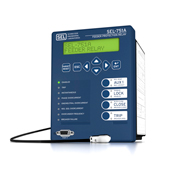Improve your personnel safety
Proposed by Schweitzer Engineering Laboratories, SEL-751 and SEL-751A Feeder Protection Relays are ideal to improve your personnel safety: the arc-flash protection reduces the incident energy of arc-flash events.
Overview
Light-sensing technology combined with fast overcurrent protection provides high-speed arc-flash detection without false tripping. With comprehensive protection capabilities, including time-overcurrent, directional overcurrent, autoreclosing, over-/undervoltage, frequency, and more, SEL-751/SEL-751A Digital Protective Relays protect radial and looped distribution circuits, making them ideal for industrial feeder protection.
Applications for Digital Protective Relays
- Protect and control radial or looped distribution circuits.
- Apply directional and nondirectional overcurrent protection for transformer/bus-main/bus-tie breakers.
- Control autoreclosing with synchronism and voltage check logic.
- Detect downed conductors and high-impedance faults with Arc Sense™ technology.
- Customize front-panel pushbutton operation and LEDs, or use default breaker trip/close functions.
- Personalize LCD messages using event-driven display point settings.
- Create an integrated control system with a variety of I/O and communications options.
- Use the programmable control logic and integration features with a communications link for control and protection of remote substations.
- Use comprehensive reporting to understand events, schedule maintenance, detect unfavorable trends, modify loads, and satisfy information requirements of supervisory systems.
- Include RTD inputs as part of system integration or to bias protection.
- Mitigate arc-flash hazards with arc-flash detection.
- Use the built-in fault locator to efficiently dispatch line inspection and repair personnel.
- Analyze overcurrent protection system performance using the built-in Sequential Events Recorder (SER).



















